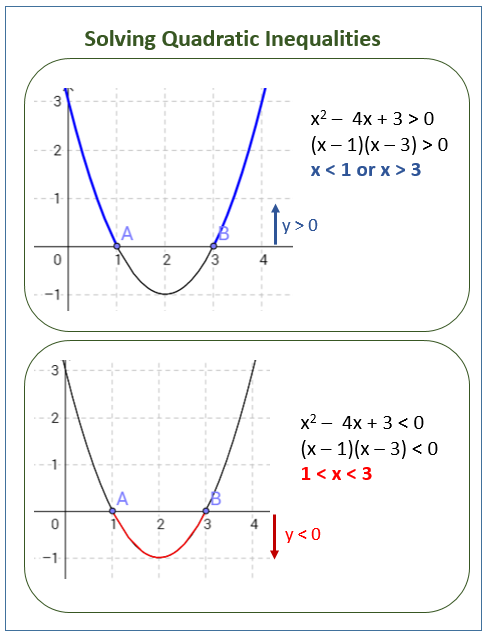Quadratic Inequalities
These free video lessons with examples and solutions help Algebra students learn how to solve quadratic inequalities.
Related Pages
Solving Quadratic Equations
Quadratic Inequalities 2
More Algebra Lessons
Example:
Solve the quadratic inequality x2 – 4x > –3
Solution:
Step 1: Make one side of the inequality zero
x2 – 4x > –3
x2 – 4x + 3 > 0
Step 2: Factor the quadratic expression
x2 – 4x + 3 > 0
(x – 3)(x – 1) > 0
Step 3: Find the range of values of x which satisfies the inequality.
(x – 3)(x – 1) > 0 (y is positive): we choose the interval for which the curve is above the x-axis.
x < 1 or x > 3
Note: If the quadratic inequality was (x – 3)(x – 1) < 0 (y is negative), we would have chosen the interval for which the curve is below the x-axis i.e. 1 < x < 3
The following graphs show the solutions for x2 – 4x + 3 > 0 and x2 – 4x + 3 < 0. Scroll down the page for more examples and solutions.

Example:
Solve 2x2 < 9x + 5
Solution:
Step 1: Make one side of the inequality zero
2x2 < 9x + 5
2x2 – 9x – 5 < 0
Step 2: Factor the quadratic expression
2x2 – 9x – 5 < 0
(2x + 1)(x – 5) < 0
Step 3: Find the range of values of x which satisfies the inequality.
(2x + 1)(x – 5) < 0 (y is negative): we choose the interval for which the curve is below the x-axis.
![]()
Note: If the quadratic inequality was (2x + 1)(x – 5) > 0
(y is positive) we would have chosen the interval for which the curve is above the x-axis i.e.
![]() or x > 5
or x > 5
How to solve quadratic inequalities?
Guidelines for solving Quadratic Inequalities
- Find all the zeros of the polynomial, and arrange the zeros in increasing order. The zeros are called its critical numbers.
- Plot those numbers on the number line as open or closed points based upon the original inequality symbol.
- Choose a test value in each interval to see if the interval satisfies the inequality or not. If the test value produces a true statement, the entire interval will be true. If the interval produces a false statement, the entire interval is false.
- Clearly graph your solution and state the solution using interval notation or inequalities.
Examples:
- Solve x2 - 6x - 16 ≤ 0
- Solve 2x2 - 11x + 12 > 0
- Solve x2 + 4 > 0
Solve a Quadratic Inequality
Example:
x2 - x - 12 ≤ 0
How to solve a Quadratic Inequality?
Example:
2x2 + 3x - 5 > 0
Solving Quadratic Inequalities
- Turn inequality into an equation.
- Find solutions.
- Make a number line, and check each solution and interval.
Example:
Solve x2 + 2x - 8 ≥ 0
Solving Quadratic Inequalities - Step by step
Example:
Find all the solutions to
2x2 + 5x - 12 ≥ 0
Solving Quadratic Inequalities
Example:
Find all the solutions to
2x2 < -4x + 6
Try the free Mathway calculator and
problem solver below to practice various math topics. Try the given examples, or type in your own
problem and check your answer with the step-by-step explanations.

We welcome your feedback, comments and questions about this site or page. Please submit your feedback or enquiries via our Feedback page.